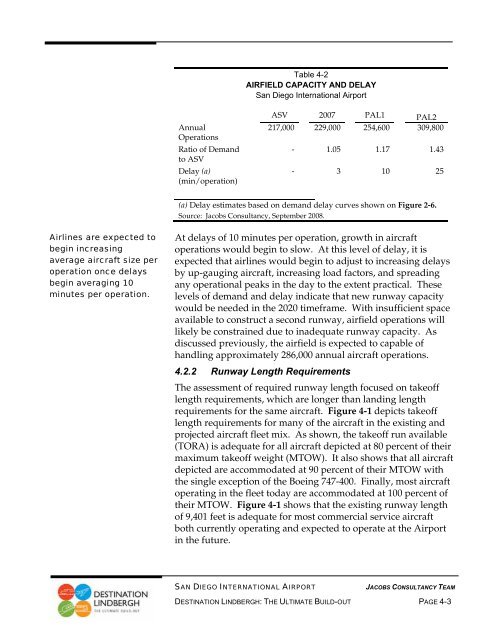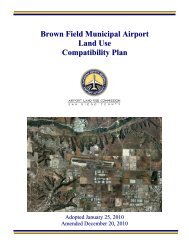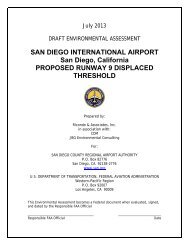chapter 4 â facility requirements - San Diego International Airport
chapter 4 â facility requirements - San Diego International Airport
chapter 4 â facility requirements - San Diego International Airport
Create successful ePaper yourself
Turn your PDF publications into a flip-book with our unique Google optimized e-Paper software.
Table 4-2<br />
AIRFIELD CAPACITY AND DELAY<br />
<strong>San</strong> <strong>Diego</strong> <strong>International</strong> <strong>Airport</strong><br />
Annual<br />
Operations<br />
Ratio of Demand<br />
to ASV<br />
Delay (a)<br />
(min/operation)<br />
ASV 2007 PAL1 PAL2<br />
217,000 229,000 254,600 309,800<br />
- 1.05 1.17 1.43<br />
- 3 10 25<br />
(a) Delay estimates based on demand delay curves shown on Figure 2-6.<br />
Source: Jacobs Consultancy, September 2008.<br />
Airlines are expected to<br />
begin increasing<br />
average aircraft size per<br />
operation once delays<br />
begin averaging 10<br />
minutes per operation.<br />
At delays of 10 minutes per operation, growth in aircraft<br />
operations would begin to slow. At this level of delay, it is<br />
expected that airlines would begin to adjust to increasing delays<br />
by up-gauging aircraft, increasing load factors, and spreading<br />
any operational peaks in the day to the extent practical. These<br />
levels of demand and delay indicate that new runway capacity<br />
would be needed in the 2020 timeframe. With insufficient space<br />
available to construct a second runway, airfield operations will<br />
likely be constrained due to inadequate runway capacity. As<br />
discussed previously, the airfield is expected to capable of<br />
handling approximately 286,000 annual aircraft operations.<br />
4.2.2 Runway Length Requirements<br />
The assessment of required runway length focused on takeoff<br />
length <strong>requirements</strong>, which are longer than landing length<br />
<strong>requirements</strong> for the same aircraft. Figure 4-1 depicts takeoff<br />
length <strong>requirements</strong> for many of the aircraft in the existing and<br />
projected aircraft fleet mix. As shown, the takeoff run available<br />
(TORA) is adequate for all aircraft depicted at 80 percent of their<br />
maximum takeoff weight (MTOW). It also shows that all aircraft<br />
depicted are accommodated at 90 percent of their MTOW with<br />
the single exception of the Boeing 747-400. Finally, most aircraft<br />
operating in the fleet today are accommodated at 100 percent of<br />
their MTOW. Figure 4-1 shows that the existing runway length<br />
of 9,401 feet is adequate for most commercial service aircraft<br />
both currently operating and expected to operate at the <strong>Airport</strong><br />
in the future.<br />
SAN DIEGO INTERNATIONAL AIRPORT<br />
JACOBS CONSULTANCY TEAM<br />
DESTINATION LINDBERGH: THE ULTIMATE BUILD-OUT PAGE 4-3
















